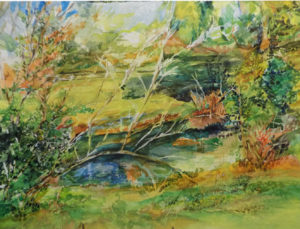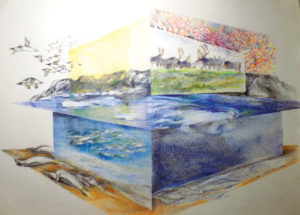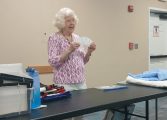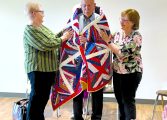By Page H. Gifford, Correspondent
Speaking with designer and artist Jane Skafte, one immediately sees the love and the passion she has for her art. Her devotion shows not only in how she speaks about her work, its meaning, and its process, but also in the joy it has given her throughout her life.
 In her teens, Skafte knew that art would be her destiny. After studying fine art at the prestigious School of the Art Institute of Chicago, she became a textile designer. Eventually, she moved to New Jersey and worked in New York as a product designer for textiles in commercial and home furnishings, and later for Lenox China and Syracuse China creating patterns for dinnerware. Many of her early experiences in design are evident in her current abstract work, which is intricate, strong and colorful. Her interlaced geometric designs are reminiscent of many of the early 20th century artists, including Robert and Sonia Delauney.
In her teens, Skafte knew that art would be her destiny. After studying fine art at the prestigious School of the Art Institute of Chicago, she became a textile designer. Eventually, she moved to New Jersey and worked in New York as a product designer for textiles in commercial and home furnishings, and later for Lenox China and Syracuse China creating patterns for dinnerware. Many of her early experiences in design are evident in her current abstract work, which is intricate, strong and colorful. Her interlaced geometric designs are reminiscent of many of the early 20th century artists, including Robert and Sonia Delauney.
But while Skafte worked in a commercial field, she never abandoned her fine art skills. “I was a museum rat and was never without my sketchbooks,” she said.
After her job as a senior designer for Syracuse China ended, she returned to school and got her Master’s in Fine Arts at Syracuse University. Teaching also allowed her to keep up with her personal art projects. “It keeps me balanced,” she said.
After years of cold winters in Syracuse, with snow as high as three-story buildings, she and her artist husband, Peter Allen, moved south to Charlottesville. Like many who migrate to Virginia, she fell in love with the Charlottesville area. She taught at James Madison University, Piedmont Virginia Community College and Blue Ridge Community College, but prefers the casualness of private lessons that do not involve grading or curriculum. Sharing techniques and ideas is liberating for her.
Eventually, they moved to a farm in Kents Store and settled into rural life with the cows and horses. She and her husband do their art work on the farm, and Skafte also works as the editorial designer for the Fluvanna Review, and teaches privately. She admitted that for a city girl it was a new experience living in the rural countryside. Rural Fluvanna is the subject of her work currently showing at the McGuffey Art Center in Charlottesville.
She has a variety of subjects she likes to draw and paint. Her landscapes like Fence and Shadow are peaceful, featuring the gentle flow of the landscape, but Sycamore Leaves returns to her stunning abstract designs, showing the strength of her personal style. She shows this in her flower paintings, including the bold and graphic Tulip and the softer but still powerful Pear Blossoms.
Most of Skafte’s work is done in watercolor, gouache, watercolor pencils and colored pencils. She prefers watercolor as her main medium but also favors colored pencils.
“While teaching I overheard one of the professors tell a student that a real artist wouldn’t use colored pencils,” Skafte said. She thought the attitude was dismissive of a drawing medium that elitist educators considered commercial. It is her “environmental” paintings in colored pencil that feature her illustrative techniques combined with her abstract designs that seem to have an effect on the onlooker. Delicate but strong colored pencil strokes are used to convey a definitive message about the work.
“They show emotional displacements. In other words, they are like a dysfunctional family: Everything looks good on the surface but is ready to erupt underneath,” she said. “People who view them tell me they are pretty because of the soft colors I use, but on closer examination they realize that the birds are dead.”
For her Carbon Footprint, the idea came in a variety of waves, not as one cohesive idea. The footprint generated the idea of the carbon footprint and the Sistine Chapel with the interaction of Michelangelo’s God and man. These became symbolic in her surreal illustration of man’s neglectful stewardship of the earth.
“I rely on mythological symbols derived from Hindu and Buddhist cosmology, and Judeo-Christian creation myths, and incorporate these into my drawings,” Skafte said. She uses these symbols to help communicate her ideas about climate change.
“The ideas for these illustrations go back to when I was an undergraduate student. It occurred to me when I noticed the two-point perspective geological illustrations in an illustrative dictionary my daughter had,” she explained. “I employed the technique of simultaneously seeing the top of the landscape and what is under ground.”
One can see her use of this method of geological illustration in her drawings, which express the shape and depth of the subject. Looking at them up close can be deceiving, because at first glance they appear like soft abstract designs, but from a distance the message is loud and clear. Mudslide, for example, features an elephant that appears to be part of the mountainous terrain buried beneath the deteriorating landscape.
Her work is compelling and has urgency and despair juxtaposed with hope. These drawings translate her concern for environmental shifts through the emotional meaning of earthly events. In looking at these illustrations, the viewer becomes aware of something more than just another pretty landscape. Skafte hopes that her work makes the onlooker think about the consequences of choices society makes and its impact on the environment, motivating change.
Nowadays, Skafte is exploring illustration combined with expressive design and graphic media. She also continues to teach. Anyone interested in learning more about Skafte’s work or finding more information about her classes should visit https://www.janeskafte.com/. or contact her at janeellen.skafte@gmail.com.




